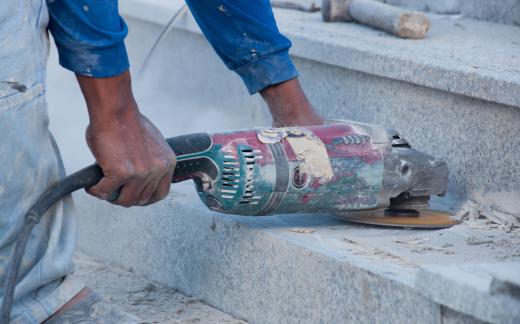An abrasive saw is a power tool used to cut hard materials, such as metals, concrete, or masonry. It can also be called a cutoff saw or a metal chop saw. The abrasive saw typically has a built-in vise or another type of clamping tool. It also has a cutting wheel and motor, which are both attached to a pivoting arm that is mounted on a base plate. The abrasive saw cuts with a replaceable abrasive disk, which is typically 14 inches (2.54 cm) in diameter.
Abrasive saw disks, or blades, differ in the size and material of the grit attached to the disk and the material used to attach the grit. Grit types include ceramic, brass, synthetic diamond, and tungsten carbide. Materials used to bond the grit include resin, plastic, metal, and electroplated bond systems.

Abrasive saws are lightweight and portable, and they can be brought to building sites. As a result, work that previously had to be performed in workshops can now be performed on-site, which made many construction jobs much easier. Abrasive saws can be used in many construction projects. Some can be used for dry cutting, wet cutting, bench grinding, or backstand grinding. The tool can also be used in the production of auto parts, ceramics and glass, plastics, electronics, and optical products.

Before using an abrasive saw, there are many safety precautions that should be considered. The user should thoroughly inspect the saw before using it. He or she should also keep in mind that an abrasive saw should never be used in a wet or damp area, because of the risk of electrocution.
If the abrasive saw is powered with compressed air, the user should make sure that the pressure doesn’t exceed the manufacturer’s recommendations. Higher pressure can create holes in hoses or force the abrasive saw to rotate at an unsafe speed. If the abrasive saw is gasoline powered, it should be used in a well-ventilated area so that the operator doesn’t inhale gasoline fumes.
The operator should make sure that the saw blade is guarded, and should never stand in front of an operating tool. When changing the abrasive disk, the use should not force the new one onto the tool. The new disk should not be used it it has been dropped or damaged in any way.
Another thing for the user to keep in mind during the tool's operation is the risk of airborne hazards. As the abrasive disk wears, it could send its grit into the air. The material being cut could also be sent into the air and damage eyes and lungs. When operating an abrasive saw, the user should always make sure to wear eye shields and a respirator.
